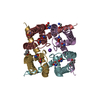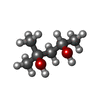[English] 日本語
 Yorodumi
Yorodumi- PDB-6cpv: MicroED structure of NaK ion channel reveals a process of Na+ par... -
+ Open data
Open data
- Basic information
Basic information
| Entry | Database: PDB / ID: 6cpv | ||||||
|---|---|---|---|---|---|---|---|
| Title | MicroED structure of NaK ion channel reveals a process of Na+ partition into the selectivity filter | ||||||
 Components Components | Potassium channel protein | ||||||
 Keywords Keywords | TRANSPORT PROTEIN / ion channel / NaK | ||||||
| Function / homology |  Function and homology information Function and homology informationpotassium channel activity / metal ion binding / identical protein binding / membrane Similarity search - Function | ||||||
| Biological species |  | ||||||
| Method | ELECTRON CRYSTALLOGRAPHY / electron crystallography /  MOLECULAR REPLACEMENT / cryo EM / Resolution: 2.5002 Å MOLECULAR REPLACEMENT / cryo EM / Resolution: 2.5002 Å | ||||||
 Authors Authors | Liu, S. / Gonen, T. | ||||||
| Funding support |  United States, 1items United States, 1items
| ||||||
 Citation Citation |  Journal: Commun Biol / Year: 2018 Journal: Commun Biol / Year: 2018Title: MicroED structure of the NaK ion channel reveals a Na partition process into the selectivity filter. Authors: Shian Liu / Tamir Gonen /  Abstract: Sodium (Na) is a ubiquitous and important inorganic salt mediating many critical biological processes such as neuronal excitation, signaling, and facilitation of various transporters. The hydration ...Sodium (Na) is a ubiquitous and important inorganic salt mediating many critical biological processes such as neuronal excitation, signaling, and facilitation of various transporters. The hydration states of Na are proposed to play critical roles in determining the conductance and the selectivity of Na channels, yet they are rarely captured by conventional structural biology means. Here we use the emerging cryo-electron microscopy (cryoEM) method micro-electron diffraction (MicroED) to study the structure of a prototypical tetrameric Na-conducting channel, NaK, to 2.5 Å resolution from nano-crystals. Two new conformations at the external site of NaK are identified, allowing us to visualize a partially hydrated Na ion at the entrance of the channel pore. A process of dilation coupled with Na movement is identified leading to valuable insights into the mechanism of ion conduction and gating. This study lays the ground work for future studies using MicroED in membrane protein biophysics. | ||||||
| History |
|
- Structure visualization
Structure visualization
| Movie |
 Movie viewer Movie viewer |
|---|---|
| Structure viewer | Molecule:  Molmil Molmil Jmol/JSmol Jmol/JSmol |
- Downloads & links
Downloads & links
- Download
Download
| PDBx/mmCIF format |  6cpv.cif.gz 6cpv.cif.gz | 52.2 KB | Display |  PDBx/mmCIF format PDBx/mmCIF format |
|---|---|---|---|---|
| PDB format |  pdb6cpv.ent.gz pdb6cpv.ent.gz | 35.2 KB | Display |  PDB format PDB format |
| PDBx/mmJSON format |  6cpv.json.gz 6cpv.json.gz | Tree view |  PDBx/mmJSON format PDBx/mmJSON format | |
| Others |  Other downloads Other downloads |
-Validation report
| Summary document |  6cpv_validation.pdf.gz 6cpv_validation.pdf.gz | 831.8 KB | Display |  wwPDB validaton report wwPDB validaton report |
|---|---|---|---|---|
| Full document |  6cpv_full_validation.pdf.gz 6cpv_full_validation.pdf.gz | 834.8 KB | Display | |
| Data in XML |  6cpv_validation.xml.gz 6cpv_validation.xml.gz | 11.7 KB | Display | |
| Data in CIF |  6cpv_validation.cif.gz 6cpv_validation.cif.gz | 15.7 KB | Display | |
| Arichive directory |  https://data.pdbj.org/pub/pdb/validation_reports/cp/6cpv https://data.pdbj.org/pub/pdb/validation_reports/cp/6cpv ftp://data.pdbj.org/pub/pdb/validation_reports/cp/6cpv ftp://data.pdbj.org/pub/pdb/validation_reports/cp/6cpv | HTTPS FTP |
-Related structure data
- Links
Links
- Assembly
Assembly
| Deposited unit | 
| |||||||||||||||||||||||||||||||||||||||
|---|---|---|---|---|---|---|---|---|---|---|---|---|---|---|---|---|---|---|---|---|---|---|---|---|---|---|---|---|---|---|---|---|---|---|---|---|---|---|---|---|
| 1 | 
| |||||||||||||||||||||||||||||||||||||||
| 2 | 
| |||||||||||||||||||||||||||||||||||||||
| Unit cell |
| |||||||||||||||||||||||||||||||||||||||
| Components on special symmetry positions |
|
- Components
Components
| #1: Protein | Mass: 10706.538 Da / Num. of mol.: 2 / Fragment: UNP residues 19-110 Source method: isolated from a genetically manipulated source Source: (gene. exp.)  Gene: A9485_19160, B4155_3291, BACERE00184_02078, CN419_22740, CN950_06075, CN980_22870, COI98_17615, COK18_26145, CON37_12595 Production host:  #2: Chemical | ChemComp-NA / #3: Chemical | ChemComp-MPD / ( | #4: Water | ChemComp-HOH / | |
|---|
-Experimental details
-Experiment
| Experiment | Method: ELECTRON CRYSTALLOGRAPHY |
|---|---|
| EM experiment | Aggregation state: 3D ARRAY / 3D reconstruction method: electron crystallography |
- Sample preparation
Sample preparation
| Component | Name: NaK / Type: COMPLEX / Entity ID: #1-#2 / Source: RECOMBINANT |
|---|---|
| Source (natural) | Organism:  |
| Source (recombinant) | Organism:  |
| Buffer solution | pH: 7 |
| Specimen | Embedding applied: NO / Shadowing applied: NO / Staining applied: NO / Vitrification applied: YES |
| Vitrification | Cryogen name: ETHANE |
-Data collection
| Experimental equipment |  Model: Tecnai F20 / Image courtesy: FEI Company |
|---|---|
| Microscopy | Model: FEI TECNAI F20 |
| Electron gun | Electron source:  FIELD EMISSION GUN / Accelerating voltage: 200 kV / Illumination mode: FLOOD BEAM FIELD EMISSION GUN / Accelerating voltage: 200 kV / Illumination mode: FLOOD BEAM |
| Electron lens | Mode: DIFFRACTION |
| Image recording | Electron dose: 0.1 e/Å2 / Film or detector model: TVIPS TEMCAM-F416 (4k x 4k) |
| EM diffraction | Camera length: 1750 mm |
| EM diffraction shell | Resolution: 2.5002→3.1486 Å / Fourier space coverage: 0.76 % / Multiplicity: 4.1 / Num. of structure factors: 2685 / Phase residual: 22.68 ° |
| EM diffraction stats | Fourier space coverage: 81.7 % / High resolution: 2.5002 Å / Num. of intensities measured: 27479 / Num. of structure factors: 5643 / Phase error: 20.27 ° / Phase residual: 20.27 ° / Phase error rejection criteria: 0 / Rmerge: 0.206 / Rsym: 0.206 |
- Processing
Processing
| Software |
| ||||||||||||||||||||||||
|---|---|---|---|---|---|---|---|---|---|---|---|---|---|---|---|---|---|---|---|---|---|---|---|---|---|
| EM 3D crystal entity | ∠α: 90 ° / ∠β: 90 ° / ∠γ: 90 ° / A: 68.0716 Å / B: 68.0716 Å / C: 89.3 Å / Space group name: I4 / Space group num: 79 | ||||||||||||||||||||||||
| CTF correction | Type: NONE | ||||||||||||||||||||||||
| 3D reconstruction | Resolution: 2.5002 Å / Resolution method: DIFFRACTION PATTERN/LAYERLINES / Symmetry type: 3D CRYSTAL | ||||||||||||||||||||||||
| Atomic model building | B value: 41 | ||||||||||||||||||||||||
| Refinement | Method to determine structure:  MOLECULAR REPLACEMENT MOLECULAR REPLACEMENTStarting model: PDB entry 3E89 Resolution: 2.5→21.992 Å / SU ML: 0.37 / Cross valid method: THROUGHOUT / σ(F): 1.41 / Phase error: 20.26
| ||||||||||||||||||||||||
| Solvent computation | Shrinkage radii: 0.9 Å / VDW probe radii: 1.11 Å | ||||||||||||||||||||||||
| Refine LS restraints |
| ||||||||||||||||||||||||
| LS refinement shell |
|
 Movie
Movie Controller
Controller














 PDBj
PDBj






